Structural determination of the complement inhibitory domain of Borrelia burgdorferi BBK32 provides insight into classical pathway complement evasion by Lyme disease spirochetes
- PMID: 30897158
- PMCID: PMC6445466
- DOI: 10.1371/journal.ppat.1007659
Structural determination of the complement inhibitory domain of Borrelia burgdorferi BBK32 provides insight into classical pathway complement evasion by Lyme disease spirochetes
Abstract
The carboxy-terminal domain of the BBK32 protein from Borrelia burgdorferi sensu stricto, termed BBK32-C, binds and inhibits the initiating serine protease of the human classical complement pathway, C1r. In this study we investigated the function of BBK32 orthologues of the Lyme-associated Borrelia burgdorferi sensu lato complex, designated BAD16 from B. afzelii strain PGau and BGD19 from B. garinii strain IP90. Our data show that B. afzelii BAD16-C exhibits BBK32-C-like activities in all assays tested, including high-affinity binding to purified C1r protease and C1 complex, and potent inhibition of the classical complement pathway. Recombinant B. garinii BGD19-C also bound C1 and C1r with high-affinity yet exhibited significantly reduced in vitro complement inhibitory activities relative to BBK32-C or BAD16-C. Interestingly, natively produced BGD19 weakly recognized C1r relative to BBK32 and BAD16 and, unlike these proteins, BGD19 did not confer significant protection from serum killing. Site-directed mutagenesis was performed to convert BBK32-C to resemble BGD19-C at three residue positions that are identical between BBK32 and BAD16 but different in BGD19. The resulting chimeric protein was designated BXK32-C and this BBK32-C variant mimicked the properties observed for BGD19-C. To query the disparate complement inhibitory activities of BBK32 orthologues, the crystal structure of BBK32-C was solved to 1.7Å limiting resolution. BBK32-C adopts an anti-parallel four-helix bundle fold with a fifth alpha-helix protruding from the helical core. The structure revealed that the three residues targeted in the BXK32-C chimera are surface-exposed, further supporting their potential relevance in C1r binding and inhibition. Additional binding assays showed that BBK32-C only recognized C1r fragments containing the serine protease domain. The structure-function studies reported here improve our understanding of how BBK32 recognizes and inhibits C1r and provide new insight into complement evasion mechanisms of Lyme-associated spirochetes of the B. burgdorferi sensu lato complex.
Conflict of interest statement
The authors have declared that no competing interests exist.
Figures

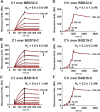
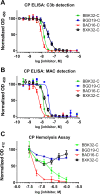
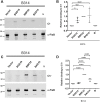
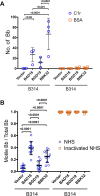
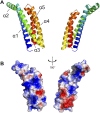

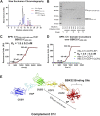
Similar articles
-
Borrelia burgdorferi BBK32 Inhibits the Classical Pathway by Blocking Activation of the C1 Complement Complex.PLoS Pathog. 2016 Jan 25;12(1):e1005404. doi: 10.1371/journal.ppat.1005404. eCollection 2016 Jan. PLoS Pathog. 2016. PMID: 26808924 Free PMC article.
-
A Structural Basis for Inhibition of the Complement Initiator Protease C1r by Lyme Disease Spirochetes.J Immunol. 2021 Dec 1;207(11):2856-2867. doi: 10.4049/jimmunol.2100815. Epub 2021 Nov 10. J Immunol. 2021. PMID: 34759015 Free PMC article.
-
Conformational dynamics of complement protease C1r inhibitor proteins from Lyme disease- and relapsing fever-causing spirochetes.J Biol Chem. 2023 Aug;299(8):104972. doi: 10.1016/j.jbc.2023.104972. Epub 2023 Jun 27. J Biol Chem. 2023. PMID: 37380082 Free PMC article.
-
Complement evasion strategies of Borrelia burgdorferi sensu lato.FEBS Lett. 2020 Aug;594(16):2645-2656. doi: 10.1002/1873-3468.13894. Epub 2020 Aug 11. FEBS Lett. 2020. PMID: 32748966 Review.
-
Immune evasion of Borrelia burgdorferi: insufficient killing of the pathogens by complement and antibody.Int J Med Microbiol. 2002 Jun;291 Suppl 33:141-6. doi: 10.1016/s1438-4221(02)80027-3. Int J Med Microbiol. 2002. PMID: 12141738 Review.
Cited by
-
A tick C1q protein alters infectivity of the Lyme disease agent by modulating interferon γ.Cell Rep. 2022 Nov 22;41(8):111673. doi: 10.1016/j.celrep.2022.111673. Cell Rep. 2022. PMID: 36417869 Free PMC article.
-
Lipoproteome screening of the Lyme disease agent identifies inhibitors of antibody-mediated complement killing.Proc Natl Acad Sci U S A. 2022 Mar 29;119(13):e2117770119. doi: 10.1073/pnas.2117770119. Epub 2022 Mar 21. Proc Natl Acad Sci U S A. 2022. PMID: 35312359 Free PMC article.
-
Antibody Cross-Reactivity in Serodiagnosis of Lyme Disease.Antibodies (Basel). 2023 Oct 5;12(4):63. doi: 10.3390/antib12040063. Antibodies (Basel). 2023. PMID: 37873860 Free PMC article. Review.
-
C1q binding to surface-bound IgG is stabilized by C1r2s2 proteases.Proc Natl Acad Sci U S A. 2021 Jun 29;118(26):e2102787118. doi: 10.1073/pnas.2102787118. Proc Natl Acad Sci U S A. 2021. PMID: 34155115 Free PMC article.
-
BBK32 attenuates antibody-dependent complement-mediated killing of infectious Borreliella burgdorferi isolates.PLoS Pathog. 2025 Jul 24;21(7):e1013361. doi: 10.1371/journal.ppat.1013361. eCollection 2025 Jul. PLoS Pathog. 2025. PMID: 40705830 Free PMC article.
References
Publication types
MeSH terms
Substances
Grants and funding
LinkOut - more resources
Full Text Sources
Other Literature Sources
Miscellaneous

